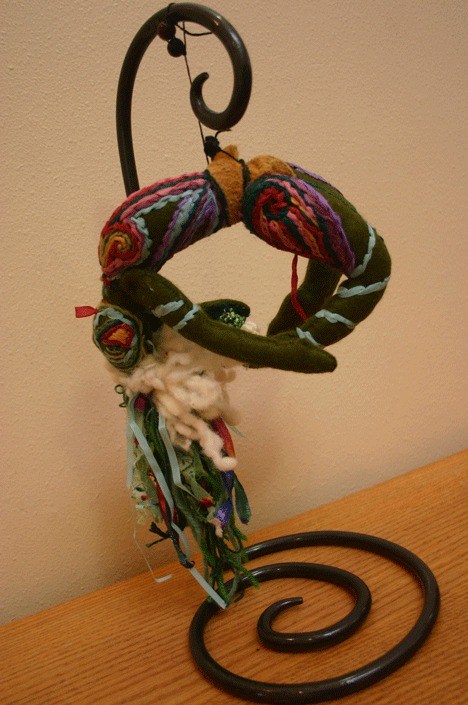Dollmaking.
It’s not an art form at the forefront of the gallery set. But, as a form, it stands as one of the oldest and most cross-cultural of the crafts.
Even the cave dwellers made dolls.
Prehistoric study reveals that dolls were made to depict religious figures, as well as being used for playthings. Back then, they were made from such primitive materials as clay, fur or wood.
Up through the last century in most of the world, handmade dolls have taken their place in museums and art galleries in all manner of style and mediums. And, although many of the dolls of the past secured their place in the important annals of folkcraft, some dolls have even reached that fashionable pinnacle of modern high art through artists such as Hans Bellmer, a German artist who in the 1930s and ’40s created surrealistic dolls with interchangeable limbs. Much later came New York City artist Greer Lankton, who became famous in the 1980s for her theatrical window displays of drug-addicted, anorexic and mutant dolls.
Mutant dolls aside, today there is a healthy number of artistic groups creating art dolls, including one on Whidbey Island, which began in February 2009.
The South Whidbey Art Doll Round Robin or “Gals and Dolls,” as they have nicknamed themselves, was started by Eibhleis Mac Ian (pronounced ay-lish).
The small group of four women have been collaborating on unique projects that in one year produced a cast of about eight characters fabricated from various materials and the personalities of their makers. You can see these dollish characters currently on display at the Freeland Library through January.
Mac Ian started making dolls three years ago, collaborating with other artists through the mail.
“I was participating in round robins on an international scale,” Mac Ian said.
“But I wasn’t ever going to get to know these people by getting a box in the mail each month.”
An art doll round robin means each person in the group receives the doll on which she works for one month, using whatever tools and materials inspire the muse.
But, Mac Ian wanted to be present with the people with whom she was creating the dolls, at least sometimes. She put an ad in the local paper.
Ginny Snyder, Kate Boyle and Pam Winstanley responded immediately, and Gals and Dolls was born.
“Each of us made a plain doll at the beginning of the year and passed it along to each member, who added a little something as it came to them,” Mac Ian said.
The pieces are one-of-a-kind sculptures lovingly imbued with personality through clothing, embroidery, jewels, journals of their histories and evocative names such as “The Merrow,” “Rabbito” and “The Marked Woman,” among other qualities.
All the women expressed their enthusiasm for the group, not just because they are creating art, but for the combination of their varied gifts that come together in a clash of fun and art. They even meet in a separate friendship group called “Stitch and Bitch” at which a variety of craft is practiced while, ahem, talking.
“We’re all levels of artist,” Boyle said. “It’s nonjudgmental; we help each other because we all have different skills.”
Snyder agreed that it was predominantly the chance to be “goofy” with a group of like-minded sensibilities that makes the creating part of Gals and Dolls that much richer for her.
“Part of the idea is to find kindred spirits who you can share a playtime with and be creative,” Snyder said. “We don’t take ourselves too seriously.”
Snyder pointed out that the dolls are less collaborative than they are a composite of all the skills and personalities of the group. Any medium can be used on the dolls and, in fact, the next round robin will not include dolls at all. They will create what’s called an “exquisite corpse,” based on a game invented by the surrealist André Breton.
Breton used words but in this case, an image is drawn onto a canvas, a section of which is given to each member of the group who has no idea of the whole and who will add what she will using various multi-media. The piece will be reassembled later to reveal a new image full of surprises.
Also planned for future endeavors is a bird to which each artist will add feathers, or at least her own idea of “feathers,” and later a round robin using sticks and stones.
“In the past it’s been almost spooky the way it comes together,” Snyder said.
Boyle said that she sees what the group is doing as the very essence of folkart in the modern world and that history shows folkartists to be predominantly women and influential to modern artists of both sexes.
“These groups have a place in art all over the world,” Boyle said.
The group will hold a presentation at the meeting room of the Freeland Library at 2 p.m. Saturday, Jan. 16 to talk about what they do and how to start an art doll round robin.
“We feel that it would inspire other artists, as well as encourage those who may not think they are artists,” Mac Ian said.
She hopes to inspire other home-grown groups to form on the island and increase the dedication to art of all kinds on the South End.


